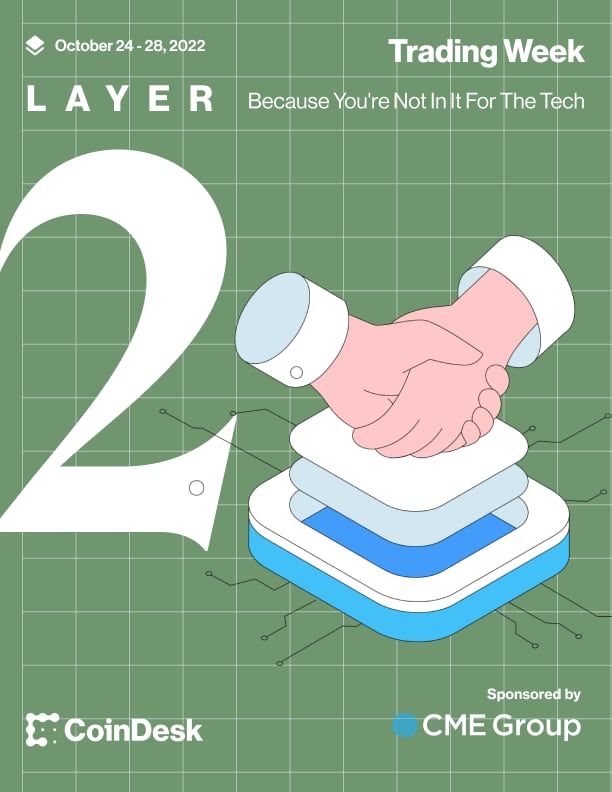Say you buy $100 worth of bitcoin thinking the price will go up 20%. If it does, and you cash out, you’ll end up with a profit of $20.
But what if you could buy $1,000 worth of bitcoin with only $100 of your funds – that’s to say, trade with leverage? If you did, you’d end up with $200 – essentially doubling your money.
This article is part of CoinDesk's Trading Week.
Sign up for CoinDesk’s Learn Crypto Investing Course.
And what if you could use that $100 to bet on the price of bitcoin going down and profit by becoming a short seller?
Well, you can. It’s called margin trading, a risky crypto strategy that lets you magnify gains and losses with borrowed funds often referred to as “leverage.”
In crypto, futures and perpetual swap markets are more popular with margin traders. Most major crypto exchanges, such as Binance, offer margin trading options. They vary by fees and leverage ratios on offer.
But caveat emptor: Crypto’s a highly volatile market, and margin trading adds extra risk, such as getting liquidated (losing your funds when you can’t pay the debt) after small market movements in the opposite direction of your bet. This is known as a “margin call” – when the traders are asked to put up more capital to guarantee their end of the trade. (There was a really good feature film about margin calls following the financial crisis of 2008. Spoiler alert: The bankers manage to save themselves while wiping out everyone else in the market.)
What is margin trading?
Margin trading, also called leveraged trading, refers to making bets on crypto markets with “leverage,” or borrowed funds, while only exposing a smaller amount of your own capital. Margin is the amount of crypto you need to enter into a leveraged position.
Margin trading positions can be opened as either:
- A short position: where you bet on the price going down
- A long position: where you bet on the price going up
In a long position, you buy a cryptocurrency in anticipation of selling it in the future when the price rises, making a profit from the price difference. This is also possible without margin. In a short position, you borrow a cryptocurrency at its current price to repurchase it when the price drops to make a profit.
Leverage is expressed in ratios, such as 20:1 or 100:1. So, if your trading account has $2,000 and you want to open a long position with a 100:1 leverage ratio, that means you’ll need to stump up collateral – using your own funds – equal to 1% of your position size. The crypto exchange will provide the remaining 99%.
Why trade on margin?
If you can just hold bitcoin and benefit from its price rises, why trade on margin? There are at least three reasons.
- To magnify gains: Trading on margin allows you to increase your profit potential if the market moves in your favor.
- Hedging: If you hold a lot of BTC and want to reduce your exposure to the risk of bitcoin’s price going down, you may hedge (manage your risks) by opening a short position.
- Short selling: Having a margin account allows you to short assets, which you can’t do with spot trading.
But the benefits have their own risks.
While you may magnify your gains by trading on margin, you may also risk losing significantly if proper risk management is not in place.
And although margin trading may help you manage risk by letting you hedge, margin interests and other transaction costs may eat into your profits.
Cross margin or isolated margin
Most exchanges will offer two types of margin: cross and isolated.
If you trade with isolated margin, you will need to assign individual margins (your funds to put up as collateral) to different trading pairs, such as BTC/USDT or ETH/USDC. The benefit is you isolate the risk to specific trading pairs, while the downside is it limits your margin level.
Cross margin lets you share the same margin (again, your collateral) in all open positions. The advantage is that it reduces your risk of liquidation in individual positions, but you may also risk getting your whole account wiped out to save one position.
Liquidation and margin call
The amount of funds the exchange requires you to hold in the margin account is called the margin level. The exchange will indicate your margin level and how “healthy” it currently is; that is, how far you are from liquidation (losing your funds when you can’t pay the debt).
And when the margin level becomes unhealthy, you risk liquidation: the forced sale of your collateral (the funds you provided for margin) to cover the loss. In crypto, this usually happens automatically (“forced liquidation”).
Before the risk becomes a reality, however, the trader will receive a “margin call” from the crypto exchange. A margin call is a notification that the trader must take action to prevent liquidation. These actions include reducing the position size, posting more collateral or reducing leverage. Forced liquidation often incurs a liquidation fee. This fee varies by exchange.
Liquidations can carry market-wide implications. A series of sizable leveraged positions getting liquidated can cause a domino effect in the markets known as a “liquidation cascade,” pushing the price of a cryptocurrency into free fall due to high volumes of forced selling.
How to manage risks
Although margin trading has its appeal, it’s a risky trade set-up for beginners without a proper risk management strategy to reduce the chances of “getting rekt,” or having their trading entire account wiped out. Here is some advice:
- Keep a separate trading account: Allocate just a certain portion to margin trading.
- Use a stop-loss: Set a price level at which you want the exchange to exit the position for you, allowing you to cut losses and eliminating the risk of losing it all.
- Take profit: Although taking profit at certain price levels reduces your overall earnings, it helps you manage risk better.
- Don’t revenge trade. After losing money in the crypto markets, it may be tempting to make it all back in one trade, but always assess your risks.
You’ll find more wisdom from crypto market experts we’ve surveyed for bear market tips here, so give it a read.
DISCLOSURE
Please note that our privacy policy, terms of use, cookies, and do not sell my personal information has been updated.
The leader in news and information on cryptocurrency, digital assets and the future of money, CoinDesk is a media outlet that strives for the highest journalistic standards and abides by a strict set of editorial policies. CoinDesk is an independent operating subsidiary of Digital Currency Group, which invests in cryptocurrencies and blockchain startups. As part of their compensation, certain CoinDesk employees, including editorial employees, may receive exposure to DCG equity in the form of stock appreciation rights, which vest over a multi-year period. CoinDesk journalists are not allowed to purchase stock outright in DCG.
:format(jpg)/cloudfront-us-east-1.images.arcpublishing.com/coindesk/YCIBLHMV4JCJRDP3OIO3BY2BPY.jpg)


:format(jpg)/cloudfront-us-east-1.images.arcpublishing.com/coindesk/DMG6DBTBSNHYRJNLOYIOQDROGI.jpg)
:format(jpg)/cloudfront-us-east-1.images.arcpublishing.com/coindesk/PFTJB3CBBZCGPEUSNCEZ7F3Z7U.jpg)
:format(jpg)/cloudfront-us-east-1.images.arcpublishing.com/coindesk/PJTR3KRDWJCRVE3QREM6KUOK7A.png)
:format(jpg)/cloudfront-us-east-1.images.arcpublishing.com/coindesk/FBKUMHO4CJFYPNW2J7ZSXYCBU4.png)


